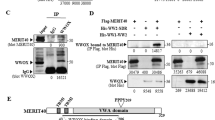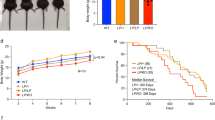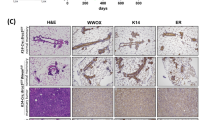Abstract
Fragile sites are chromosomal structures that have been proposed to have a determining role in cancer-associated DNA instability. The human WWOX gene spans the FRA16D chromosomal fragile site, the common minimal region of homozygous deletion found in adenocarcinomas and three out of five translocation breakpoints in multiple myeloma. Transcripts from the alternatively spliced WWOX gene encode proteins with common N-terminal WW domains and variable homology to the oxidoreductase family of proteins. In this study, the Drosophila orthologue of the WWOX gene was identified and subjected to mutagenesis via homologous recombination. The resultant DmWWOX1 mutants were viable but exhibited an increased sensitivity to ionizing radiation. This radiation sensitivity was rescued by reintroduction and expression of either the wild-type Drosophila or human WWOX genes. Thus, the protective function of DmWWOX in response to irradiation in Drosophila is conserved with human WWOX (hWWOX). This is consistent with a protective role for hWWOX where aberrant expression, as a result of breakage at the associated fragile site, could contribute directly to cancer progression.
This is a preview of subscription content, access via your institution
Access options
Subscribe to this journal
Receive 50 print issues and online access
$259.00 per year
only $5.18 per issue
Buy this article
- Purchase on SpringerLink
- Instant access to full article PDF
Prices may be subject to local taxes which are calculated during checkout



Similar content being viewed by others
References
Aqeilan RI, Kuroki T, Pekarsky Y, Albagha O, Trapasso F, Baffa R, Huebner K, Edmonds P and Croce CM . (2004a). Clin. Cancer Res., 10, 3053–3058.
Aqeilan RI, Palamarchuk A, Weigel RJ, Herrero JJ, Pekarsky Y and Croce CM . (2004b). Cancer Res., 64, 8256–8261.
Aqeilan RI, Pekarsky Y, Herrero JJ, Palamarchuk A, Letofsky J, Druck T, Trapasso F, Han SY, Melino G, Huebner K and Croce CM . (2004c). Proc. Natl. Acad. Sci. USA, 101, 4401–4406.
Bednarek AK, Keck-Waggoner CL, Daniel RL, Laflin KJ, Bergsagel PL, Kiguchi K, Brenner AJ and Aldaz CM . (2001). Cancer Res., 61, 8068–8073.
Bednarek AK, Laflin KJ, Daniel RL, Liao Q, Hawkins KA and Aldaz CM . (2000). Cancer Res., 60, 2140–2145.
Bluteau O, Beaudoin JC, Pasturaud P, Belghiti J, Franco D, Bioulac-Sage P, Laurent-Puig P and Zucman-Rossi J . (2002). Oncogene, 21, 1225–1232.
Brand AH and Perrimon N . (1993). Development, 118, 401–415.
Cesari R, Martin ES, Calin GA, Pentimalli F, Bichi R, McAdams H, Trapasso F, Drusco A, Shimizu M, Masciullo V, D’Andrilli G, Scambia G, Picchio MC, Alder H, Godwin AK and Croce CM . (2003). Proc. Natl. Acad. Sci. USA, 100, 5956–5961.
Chang NS, Doherty J and Ensign A . (2003). J. Biol. Chem., 278, 9195–9202.
Chang NS, Pratt N, Heath J, Schultz L, Sleve D, Carey GB and Zevotek N . (2001). J. Biol. Chem., 276, 3361–3370.
Denison SR, Wang F, Becker NA, Schule B, Kock N, Phillips LA, Klein C and Smith DI . (2003). Oncogene, 22, 8370–8378.
Driouch K, Prydz H, Monese R, Johansen H, Lidereau R and Frengen E . (2002). Oncogene, 21, 1832–1840.
Finnis M, Dayan S, Hobson L, Chenevix-Trench G, Friend K, Ried K, Venter D, Woollatt E, Baker E and Richards RI . (2005). Hum. Mol. Genet., 14, 1341–1349.
Glover TW, Hoge AW, Miller DE, Ascara-Wilke JE, Adam AN, Dagenais SL, Wilke CM, Dierick HA and Beer DG . (1998). Cancer Res., 58, 3409–3414.
Guler G, Uner A, Guler N, Han SY, Iliopoulos D, Hauck WW, McCue P and Huebner K . (2004). Cancer, 100, 1605–1614.
Ishii H, Vecchione A, Furukawa Y, Sutheesophon K, Han SY, Druck T, Kuroki T, Trapasso F, Nishimura M, Saito Y, Ozawa K, Croce CM and Huebner K . (2003). Mol. Cancer Res., 1, 940–947.
Jaklevic BR and Su TT . (2004). Curr. Biol., 14, 23–32.
Krummel KA, Denison SR, Calhoun E, Phillips LA and Smith DI . (2002). Genes Chromosomes Cancer, 34, 154–167.
Kuroki T, Trapasso F, Shiraishi T, Alder H, Mimori K, Mori M and Croce CM . (2002). Cancer Res., 62, 2258–2260.
Kuroki T, Yendamuri S, Trapasso F, Matsuyama A, Aqeilan RI, Alder H, Rattan S, Cesari R, Nolli ML, Williams NN, Mori M, Kanematsu T and Croce CM . (2004). Clin. Cancer Res., 10, 2459–2465.
Lee J, Lee E, Park J, Kim E, Kim J and Chung J . (2003). FEBS Lett., 550, 5–10.
Ludes-Meyers JH, Kil H, Bednarek AK, Drake J, Bedford MT and Aldaz CM . (2004). Oncogene, 23, 5049–5055.
Mangelsdorf M, Ried K, Woollatt E, Dayan S, Eyre H, Finnis M, Hobson L, Nancarrow J, Venter D, Baker E and Richards RI . (2000). Cancer Res., 60, 1683–1689.
Nioi P and Hayes JD . (2004). Mutat. Res., 555, 149–171.
Paige AJ, Taylor KJ, Taylor C, Hillier SG, Farrington S, Scott D, Porteous DJ, Smyth JF, Gabra H and Watson JE . (2001). Proc. Natl. Acad. Sci. USA, 98, 11417–11422.
Pekarsky Y, Zanesi N, Palamarchuk A, Huebner K and Croce CM . (2002). Lancet Oncol., 3, 748–754.
Picchio MC, Martin ES, Cesari R, Calin GA, Yendamuri S, Kuroki T, Pentimalli F, Sarti M, Yoder K, Kaiser LR, Fishel R and Croce CM . (2004). Clin. Cancer Res., 10, 2720–2724.
Richards RI . (2001). Trends Genet., 17, 339–345.
Ried K, Finnis M, Hobson L, Mangelsdorf M, Dayan S, Nancarrow JK, Woollatt E, Kremmidiotis G, Gardner A, Venter D, Baker E and Richards RI . (2000). Hum. Mol. Genet., 9, 1651–1663.
Rong YS, Titen SW, Xie HB, Golic MM, Bastiani M, Bandyopadhayay P, Olivera BM, Brodsky M, Rubin GM and Golic KG . (2002). Genes Dev., 16, 1568–1581.
Rozier L, El-Achkar E, Apiou F and Debatisse M . (2004). Oncogene, 23, 6872–6880.
Sogame N, Kim M and Abrams JM . (2003). Proc. Natl. Acad. Sci. USA, 100, 4696–4701.
Sze CI, Su M, Pugazhenthi S, Jambal P, Hsu LJ, Heath J, Schultz L and Chang NS . (2004). J. Biol. Chem., 279, 30498–30506.
Wang F, Denison S, Lai JP, Philips LA, Montoya D, Kock N, Schule B, Klein C, Shridhar V, Roberts LR and Smith DI . (2004). Genes Chromosomes Cancer, 40, 85–96.
Watanabe A, Hippo Y, Taniguchi H, Iwanari H, Yashiro M, Hirakawa K, Kodama T and Aburatani H . (2003). Cancer Res., 63, 8629–8633.
Wiesner S, Stier G, Sattler M and Macias M . (2002). J. Mol. Biol., 324, 807–822.
Yakicier MC, Legoix P, Vaury C, Gressin L, Tubacher E, Capron F, Bayer J, Degott C, Balabaud C and Zucman-Rossi J . (2001). Oncogene, 20, 5232–5238.
Yendamuri S, Kuroki T, Trapasso F, Henry AC, Dumon KR, Huebner K, Williams NN, Kaiser LR and Croce CM . (2003). Cancer Res., 63, 878–881.
Zanesi N, Fidanza V, Fong LY, Mancini R, Druck T, Valtieri M, Rudiger T, McCue PA, Croce CM and Huebner K . (2001). Proc. Natl. Acad. Sci. USA, 98, 10250–10255.
Acknowledgements
We would like to thank V Evci and J Mackrill for technical assistance, the IMVS Transfusion Medicine Unit for the kind use of their irradiation machine and members of the Richards lab for their constructive comments on drafts of this manuscript. This work was supported, in part, by grant (207809) from the National Health and Medical Research Council, Australia to RIR and the ARC Special Research Centre for the Molecular Genetics of Development from the Australian Research Council to RIR and RBS. LVO is the recipient of a Peter Doherty Post-doctoral Research Fellowship (207830) from the National Health and Medical Research Council, Australia.
Author information
Authors and Affiliations
Corresponding author
Additional information
Supplementary Information accompanies the paper on Oncogene website (http://www.nature.com/onc)
Supplementary information
Rights and permissions
About this article
Cite this article
O'Keefe, L., Liu, Y., Perkins, A. et al. FRA16D common chromosomal fragile site oxido-reductase (FOR/WWOX) protects against the effects of ionizing radiation in Drosophila. Oncogene 24, 6590–6596 (2005). https://doi.org/10.1038/sj.onc.1208806
Received:
Revised:
Accepted:
Published:
Issue date:
DOI: https://doi.org/10.1038/sj.onc.1208806



